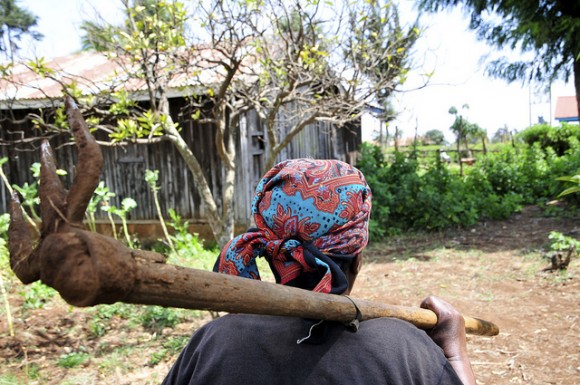A few years ago, my grandparents came to visit my husband and me in London. It was a Sunday, so we welcomed them with a lovely, organic roast chicken. Unfortunately, it didn’t go down too well, particularly with my (now late) grandmother. And this is why.
My grandmother comes from a beautiful part of Kenya, on the foot of Mount Kenya, close to the area where the late Wangari Maathai, the Nobel Peace Prize winning environmental activist, was born. As a child, taken by my parents to see my grandparents, I don’t think I quite appreciated the beauty of their home. Back then, there were deep, dark forests, where elephants and other wild animals roamed, and a roaring river in the valley. Even though much of those forests are now gone (due to commercial logging), and the river is not quite so roaring anymore, it’s still beautiful. And the backdrop of the snow-tipped Mount Kenya is unforgettable.
As a child, I also didn’t appreciate how close to nature we were. There’s still no electricity or running water there, and my family mostly eats what they farm and sells the rest. They tend vegetables such as corn, potatoes and carrots, and rear chickens, rabbits, sheep and cows. They are close to and depend on nature – it is their life and livelihood.

It’s because she was so close to nature that my grandmother wasn’t too enthusiastic about our roast chicken. Here in the UK, it’s often hard to understand the differences between the foods we eat. Different meats are in similar packaging, and if we go for a nice Sunday lunch, the price for chicken, beef or lamb roasts tend to differ by only a few pounds, if at all. We only get big discounts if we go for vegetarian options. But for my grandmother, a plate of chicken definitely had less value than a plate of beef. Because she was close to nature, she knew that it would take a great deal more effort to look after and feed a cow than it would a chicken. She instinctively knew the effort (and energy) required to produce food. An effort that those of us working on climate change grapple with every day.
This effort is reflected in how much carbon dioxide and natural resources are associated with different foods. Back in 2006, the UN Food and Agriculture Organisation – who set up World Food Day – released a report saying that nearly a fifth of all greenhouse gas emissions come from livestock – that’s more than from all forms of transport. Just the dairy cattle sector accounts for 4% of global emissions. The average water footprint of a kilogram of beef has been calculated at 15,000 litres, versus 4,300 for a kilo of chicken and 250 litres for a kilo of potatoes. This infographic, put together last month by a US institute, calculates the carbon footprint of 20 different foods, and compares that to car miles. It suggests that eating just one less burger per week (in the US) is the equivalent to not driving 320 miles.
That’s why people like Lord Stern in 2009 and Al Gore more recently have respectively advocated becoming vegetarian or cutting down on meat consumption, in order to help avoid climate change and other natural resource scarcities. The UK’s Foresight Global Food and Farming Futures Report, an authoritative report published earlier this year, includes a chapter called “Challenge A” devoted to these issues – it’s really worth a read, as it also explains other complex effects of food consumption choices on developing countries – such as impacts on trade.
While these issues are very complex, the simple point for my grandmother was that visiting my home was a special occasion. A special occasion that happened less than every five years that she thought should be associated with a high value meal like beef or lamb. For her, chicken didn’t quite hit the spot. Being close to nature, she could make that judgement.
In a time where food prices across the board seem to be rising, threatening livelihoods across the world, understanding the implications of the food choices we make is crucial. It’s often hard to do so, particularly if we live in cities and don’t get to the countryside or farms that often. Given that over half of the world’s population live in cities, we must find a way to connect us all with the way food is produced. Clearer packaging and pricing could be one crucial indicator. Of course, staple foods like corn, grains and beans, of the sort my grandmother used to eat every day rather than on special occasions, must remain affordable and accessible. But it may not be so bad a thing for some food prices to slowly begin to more closely reflect their carbon and natural resource content. That may well help us – particularly in countries such as the UK – to make better choices. It might help us choose vegetables on most days and meat only on special occasions. By doing so, we will not only stay healthier, but we might also just help slow climate change, and preserve the snow on the tip of Mount Kenya, close to where my discerning grandmother now rests in peace.
